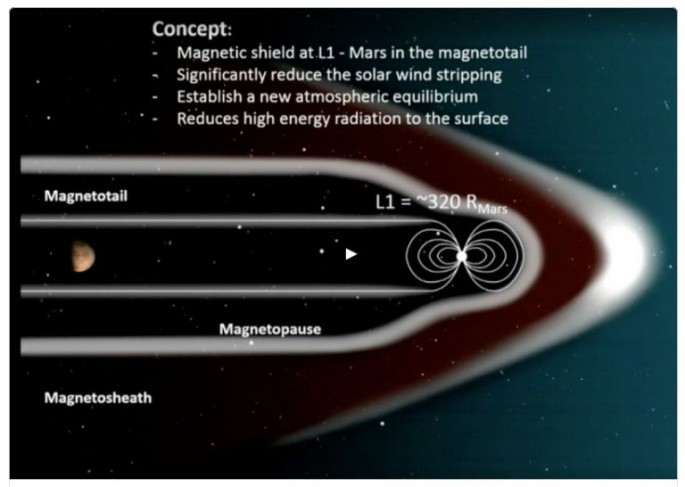NASA has revealed a bold plan to terraform Mars into a habitable planet by deploying a man-made magnetic shield around the planet.
NASA's Planetary Science Division (PSD) Director James Green explained how NASA can accomplish this jaw dropping plan of deploying a "magnetic shield" into a stable orbit between the Sun and Mars to protect Mars from destructive solar winds and deadly radiation.
With a shield in place, humans can explore Mars unimpeded without the risk of radiation exposure and asphyxiation.
Green said the magnetic shield will be made of a large dipole powerful enough to generate an artificial magnetic field shrouding the entire planet. With the shield installed and stabilized, Mars can slowly regain its atmosphere, making it habitable for human explorers in only a matter of years.
"This new research is coming about due to the application of full plasma physics codes and laboratory experiments," explained Green.
"In the future it is quite possible that an inflatable structure(s) can generate a magnetic dipole field at a level of perhaps 1 or 2 Tesla (or 10,000 to 20,000 Gauss) as an active shield against the solar wind."
Green's modeling of the shield found that the structure might enable Mars to generate half the atmospheric pressure of the Earth in a matter of years. The greenhouse effect to be triggered by the terraforming will start to heat the planet and eventually melt the ice under its poles.
"Perhaps one-seventh of the ancient ocean could return to Mars," believes Green.
"The solar system is ours, let's take it. That of course includes Mars and for humans to be able to explore Mars, together, with us doing science, we need a better environment."
The shield might help transform Mars into a habitable planet in the next 100 years.
Scientists know that Mars once had a magnetic field strong enough to preserve its atmosphere. This protective shield, however, suddenly dissipated 4.2 billion years ago. Over the next 500 million years, Mars gradually became colder and drier, making it incapable of sustaining life.
Green and his fellow scientists said they've made calculations that point to the possibility of restoring 1/7th of Mars' oceans -- the same quantity it had lost billions of years ago.
"A greatly enhanced Martian atmosphere, in both pressure and temperature, that would be enough to allow significant surface liquid water would also have a number of benefits for science and human exploration in the 2040s and beyond," said Green.
"Much like Earth, an enhanced atmosphere would allow larger landed mass of equipment to the surface; shield against most cosmic and solar particle radiation; extend the ability for oxygen extraction and provide 'open air' greenhouses to exist for plant production, just to name a few."



























